Analysing Organisational Behaviour Theories for Employee Performance
VerifiedAdded on 2020/05/28
|8
|2442
|328
Essay
AI Summary
This essay delves into the crucial role of organizational behavior theories in enhancing employee performance within modern corporations. It highlights how companies utilize these theories to understand individual and group behavior, ultimately aiming to improve productivity and create a positive work environment. The essay examines the significance of leadership in implementing strategies such as goal setting, job design, and fostering motivating work conditions. It analyzes various organizational behavior theories, including the Common Sense Theory (Theory X and Y), Herzberg's Two Factor Theory, Behavioral Management Theory, Weber’s Theory of Bureaucracy, Goal-Setting Theory, Expectancy Theory, and Hierarchy of Needs, and how managers can apply them to address issues like job dissatisfaction, communication problems, and lack of motivation. Furthermore, the essay provides recommendations for effectively implementing these theories to achieve a competitive advantage and ensure sustainable growth. The essay emphasizes the importance of adapting organizational behavior strategies to specific company needs and market conditions.
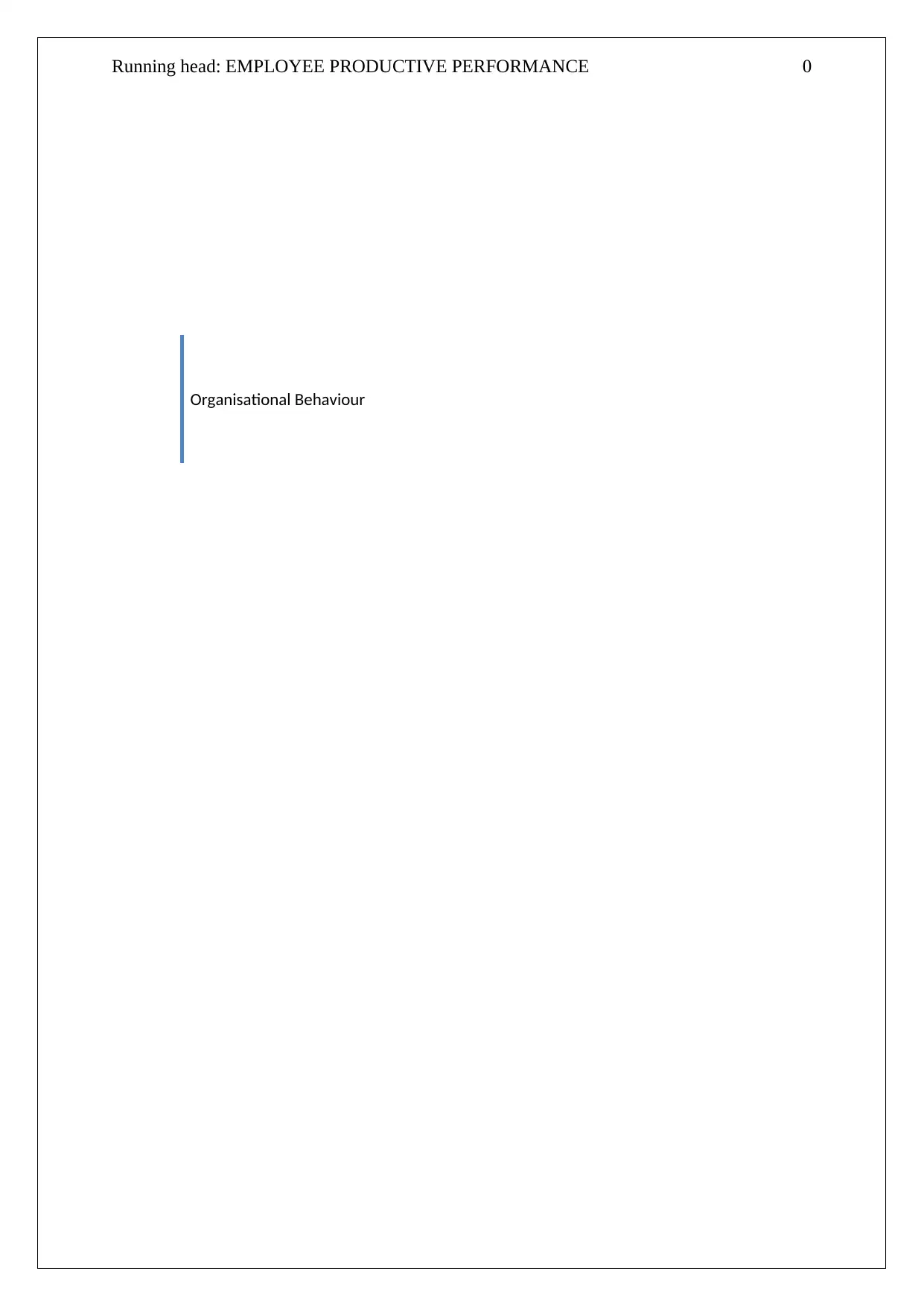
Running head: EMPLOYEE PRODUCTIVE PERFORMANCE 0
Organisational Behaviour
Organisational Behaviour
Paraphrase This Document
Need a fresh take? Get an instant paraphrase of this document with our AI Paraphraser
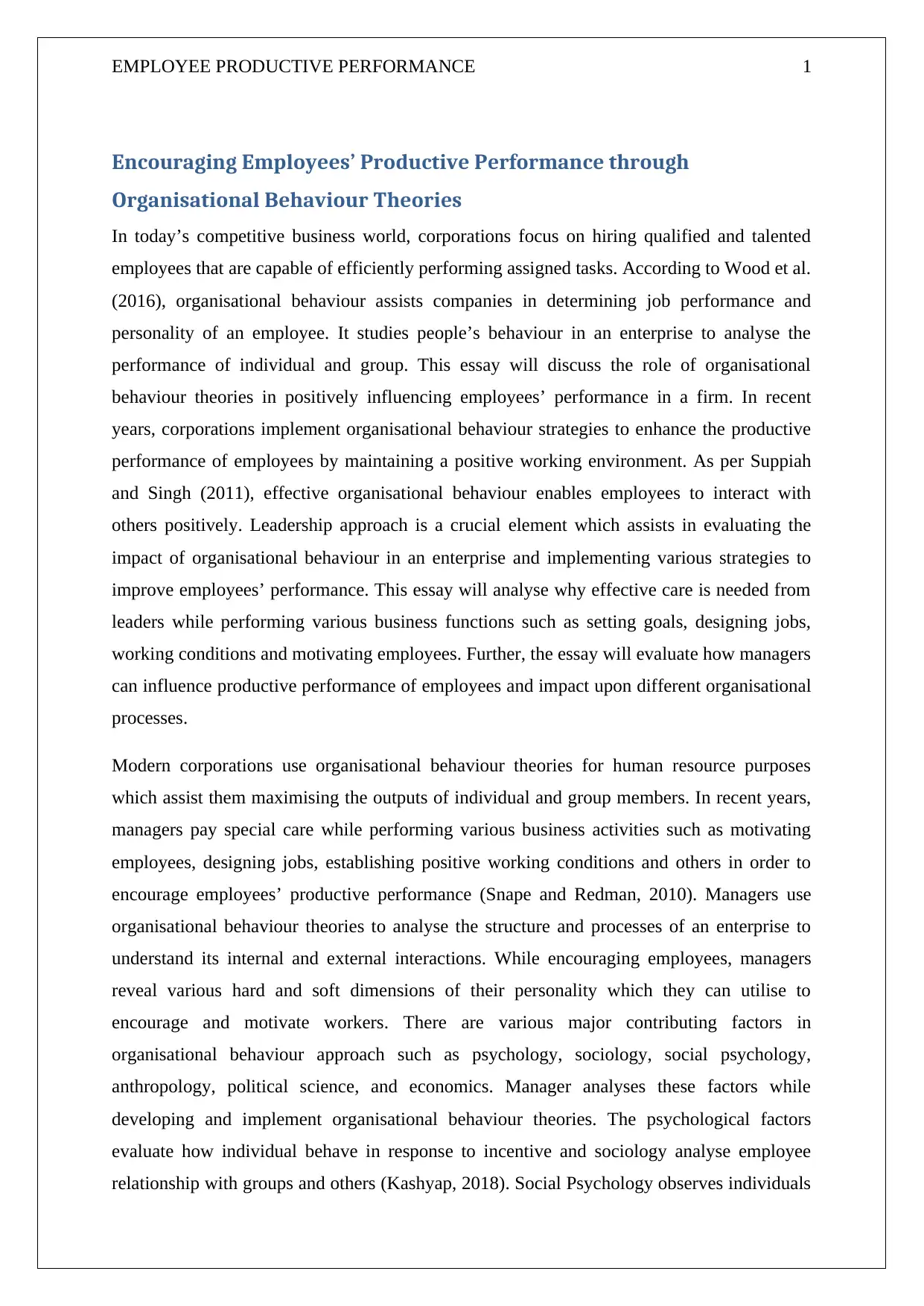
EMPLOYEE PRODUCTIVE PERFORMANCE 1
Encouraging Employees’ Productive Performance through
Organisational Behaviour Theories
In today’s competitive business world, corporations focus on hiring qualified and talented
employees that are capable of efficiently performing assigned tasks. According to Wood et al.
(2016), organisational behaviour assists companies in determining job performance and
personality of an employee. It studies people’s behaviour in an enterprise to analyse the
performance of individual and group. This essay will discuss the role of organisational
behaviour theories in positively influencing employees’ performance in a firm. In recent
years, corporations implement organisational behaviour strategies to enhance the productive
performance of employees by maintaining a positive working environment. As per Suppiah
and Singh (2011), effective organisational behaviour enables employees to interact with
others positively. Leadership approach is a crucial element which assists in evaluating the
impact of organisational behaviour in an enterprise and implementing various strategies to
improve employees’ performance. This essay will analyse why effective care is needed from
leaders while performing various business functions such as setting goals, designing jobs,
working conditions and motivating employees. Further, the essay will evaluate how managers
can influence productive performance of employees and impact upon different organisational
processes.
Modern corporations use organisational behaviour theories for human resource purposes
which assist them maximising the outputs of individual and group members. In recent years,
managers pay special care while performing various business activities such as motivating
employees, designing jobs, establishing positive working conditions and others in order to
encourage employees’ productive performance (Snape and Redman, 2010). Managers use
organisational behaviour theories to analyse the structure and processes of an enterprise to
understand its internal and external interactions. While encouraging employees, managers
reveal various hard and soft dimensions of their personality which they can utilise to
encourage and motivate workers. There are various major contributing factors in
organisational behaviour approach such as psychology, sociology, social psychology,
anthropology, political science, and economics. Manager analyses these factors while
developing and implement organisational behaviour theories. The psychological factors
evaluate how individual behave in response to incentive and sociology analyse employee
relationship with groups and others (Kashyap, 2018). Social Psychology observes individuals
Encouraging Employees’ Productive Performance through
Organisational Behaviour Theories
In today’s competitive business world, corporations focus on hiring qualified and talented
employees that are capable of efficiently performing assigned tasks. According to Wood et al.
(2016), organisational behaviour assists companies in determining job performance and
personality of an employee. It studies people’s behaviour in an enterprise to analyse the
performance of individual and group. This essay will discuss the role of organisational
behaviour theories in positively influencing employees’ performance in a firm. In recent
years, corporations implement organisational behaviour strategies to enhance the productive
performance of employees by maintaining a positive working environment. As per Suppiah
and Singh (2011), effective organisational behaviour enables employees to interact with
others positively. Leadership approach is a crucial element which assists in evaluating the
impact of organisational behaviour in an enterprise and implementing various strategies to
improve employees’ performance. This essay will analyse why effective care is needed from
leaders while performing various business functions such as setting goals, designing jobs,
working conditions and motivating employees. Further, the essay will evaluate how managers
can influence productive performance of employees and impact upon different organisational
processes.
Modern corporations use organisational behaviour theories for human resource purposes
which assist them maximising the outputs of individual and group members. In recent years,
managers pay special care while performing various business activities such as motivating
employees, designing jobs, establishing positive working conditions and others in order to
encourage employees’ productive performance (Snape and Redman, 2010). Managers use
organisational behaviour theories to analyse the structure and processes of an enterprise to
understand its internal and external interactions. While encouraging employees, managers
reveal various hard and soft dimensions of their personality which they can utilise to
encourage and motivate workers. There are various major contributing factors in
organisational behaviour approach such as psychology, sociology, social psychology,
anthropology, political science, and economics. Manager analyses these factors while
developing and implement organisational behaviour theories. The psychological factors
evaluate how individual behave in response to incentive and sociology analyse employee
relationship with groups and others (Kashyap, 2018). Social Psychology observes individuals
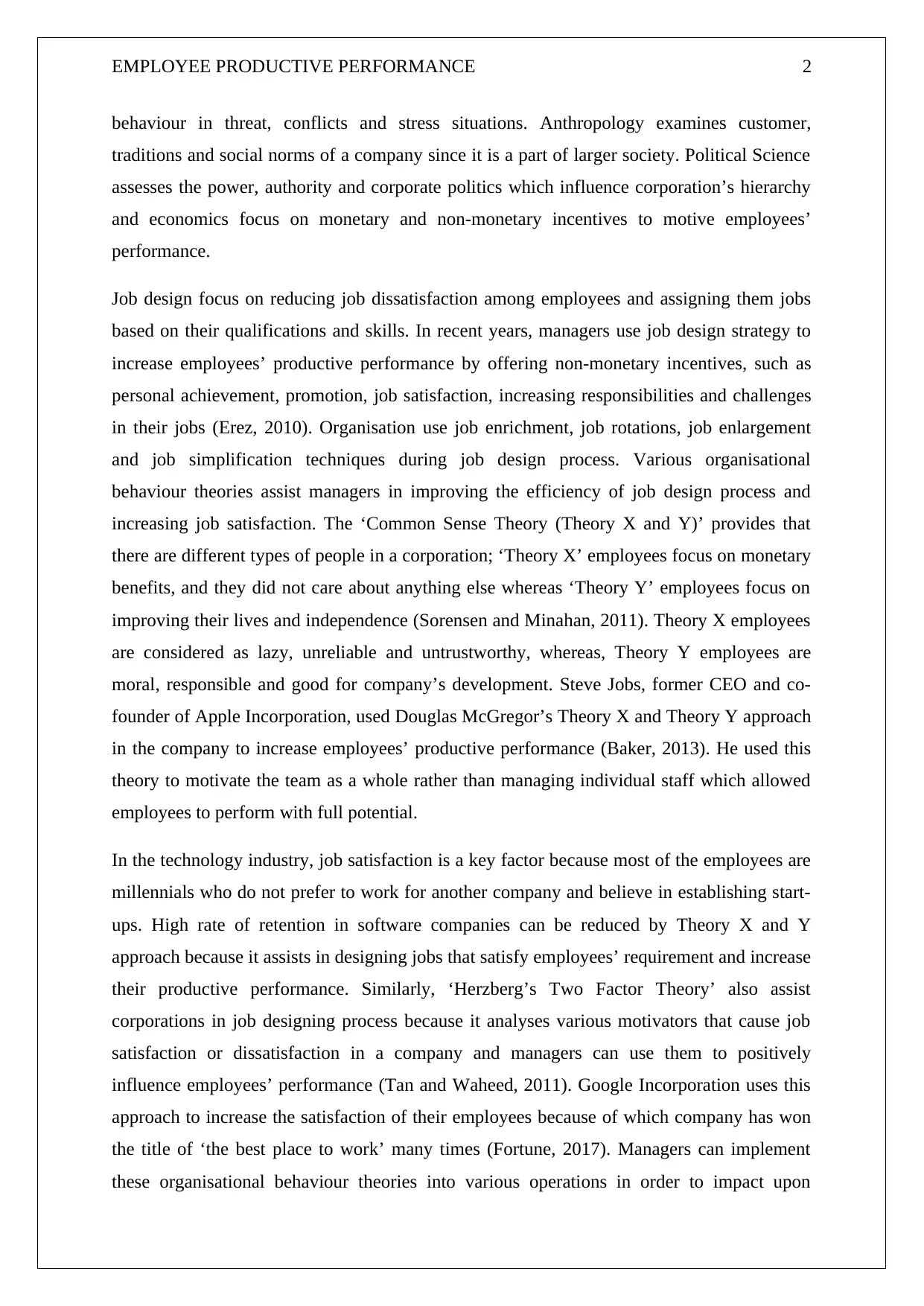
EMPLOYEE PRODUCTIVE PERFORMANCE 2
behaviour in threat, conflicts and stress situations. Anthropology examines customer,
traditions and social norms of a company since it is a part of larger society. Political Science
assesses the power, authority and corporate politics which influence corporation’s hierarchy
and economics focus on monetary and non-monetary incentives to motive employees’
performance.
Job design focus on reducing job dissatisfaction among employees and assigning them jobs
based on their qualifications and skills. In recent years, managers use job design strategy to
increase employees’ productive performance by offering non-monetary incentives, such as
personal achievement, promotion, job satisfaction, increasing responsibilities and challenges
in their jobs (Erez, 2010). Organisation use job enrichment, job rotations, job enlargement
and job simplification techniques during job design process. Various organisational
behaviour theories assist managers in improving the efficiency of job design process and
increasing job satisfaction. The ‘Common Sense Theory (Theory X and Y)’ provides that
there are different types of people in a corporation; ‘Theory X’ employees focus on monetary
benefits, and they did not care about anything else whereas ‘Theory Y’ employees focus on
improving their lives and independence (Sorensen and Minahan, 2011). Theory X employees
are considered as lazy, unreliable and untrustworthy, whereas, Theory Y employees are
moral, responsible and good for company’s development. Steve Jobs, former CEO and co-
founder of Apple Incorporation, used Douglas McGregor’s Theory X and Theory Y approach
in the company to increase employees’ productive performance (Baker, 2013). He used this
theory to motivate the team as a whole rather than managing individual staff which allowed
employees to perform with full potential.
In the technology industry, job satisfaction is a key factor because most of the employees are
millennials who do not prefer to work for another company and believe in establishing start-
ups. High rate of retention in software companies can be reduced by Theory X and Y
approach because it assists in designing jobs that satisfy employees’ requirement and increase
their productive performance. Similarly, ‘Herzberg’s Two Factor Theory’ also assist
corporations in job designing process because it analyses various motivators that cause job
satisfaction or dissatisfaction in a company and managers can use them to positively
influence employees’ performance (Tan and Waheed, 2011). Google Incorporation uses this
approach to increase the satisfaction of their employees because of which company has won
the title of ‘the best place to work’ many times (Fortune, 2017). Managers can implement
these organisational behaviour theories into various operations in order to impact upon
behaviour in threat, conflicts and stress situations. Anthropology examines customer,
traditions and social norms of a company since it is a part of larger society. Political Science
assesses the power, authority and corporate politics which influence corporation’s hierarchy
and economics focus on monetary and non-monetary incentives to motive employees’
performance.
Job design focus on reducing job dissatisfaction among employees and assigning them jobs
based on their qualifications and skills. In recent years, managers use job design strategy to
increase employees’ productive performance by offering non-monetary incentives, such as
personal achievement, promotion, job satisfaction, increasing responsibilities and challenges
in their jobs (Erez, 2010). Organisation use job enrichment, job rotations, job enlargement
and job simplification techniques during job design process. Various organisational
behaviour theories assist managers in improving the efficiency of job design process and
increasing job satisfaction. The ‘Common Sense Theory (Theory X and Y)’ provides that
there are different types of people in a corporation; ‘Theory X’ employees focus on monetary
benefits, and they did not care about anything else whereas ‘Theory Y’ employees focus on
improving their lives and independence (Sorensen and Minahan, 2011). Theory X employees
are considered as lazy, unreliable and untrustworthy, whereas, Theory Y employees are
moral, responsible and good for company’s development. Steve Jobs, former CEO and co-
founder of Apple Incorporation, used Douglas McGregor’s Theory X and Theory Y approach
in the company to increase employees’ productive performance (Baker, 2013). He used this
theory to motivate the team as a whole rather than managing individual staff which allowed
employees to perform with full potential.
In the technology industry, job satisfaction is a key factor because most of the employees are
millennials who do not prefer to work for another company and believe in establishing start-
ups. High rate of retention in software companies can be reduced by Theory X and Y
approach because it assists in designing jobs that satisfy employees’ requirement and increase
their productive performance. Similarly, ‘Herzberg’s Two Factor Theory’ also assist
corporations in job designing process because it analyses various motivators that cause job
satisfaction or dissatisfaction in a company and managers can use them to positively
influence employees’ performance (Tan and Waheed, 2011). Google Incorporation uses this
approach to increase the satisfaction of their employees because of which company has won
the title of ‘the best place to work’ many times (Fortune, 2017). Managers can implement
these organisational behaviour theories into various operations in order to impact upon
⊘ This is a preview!⊘
Do you want full access?
Subscribe today to unlock all pages.

Trusted by 1+ million students worldwide
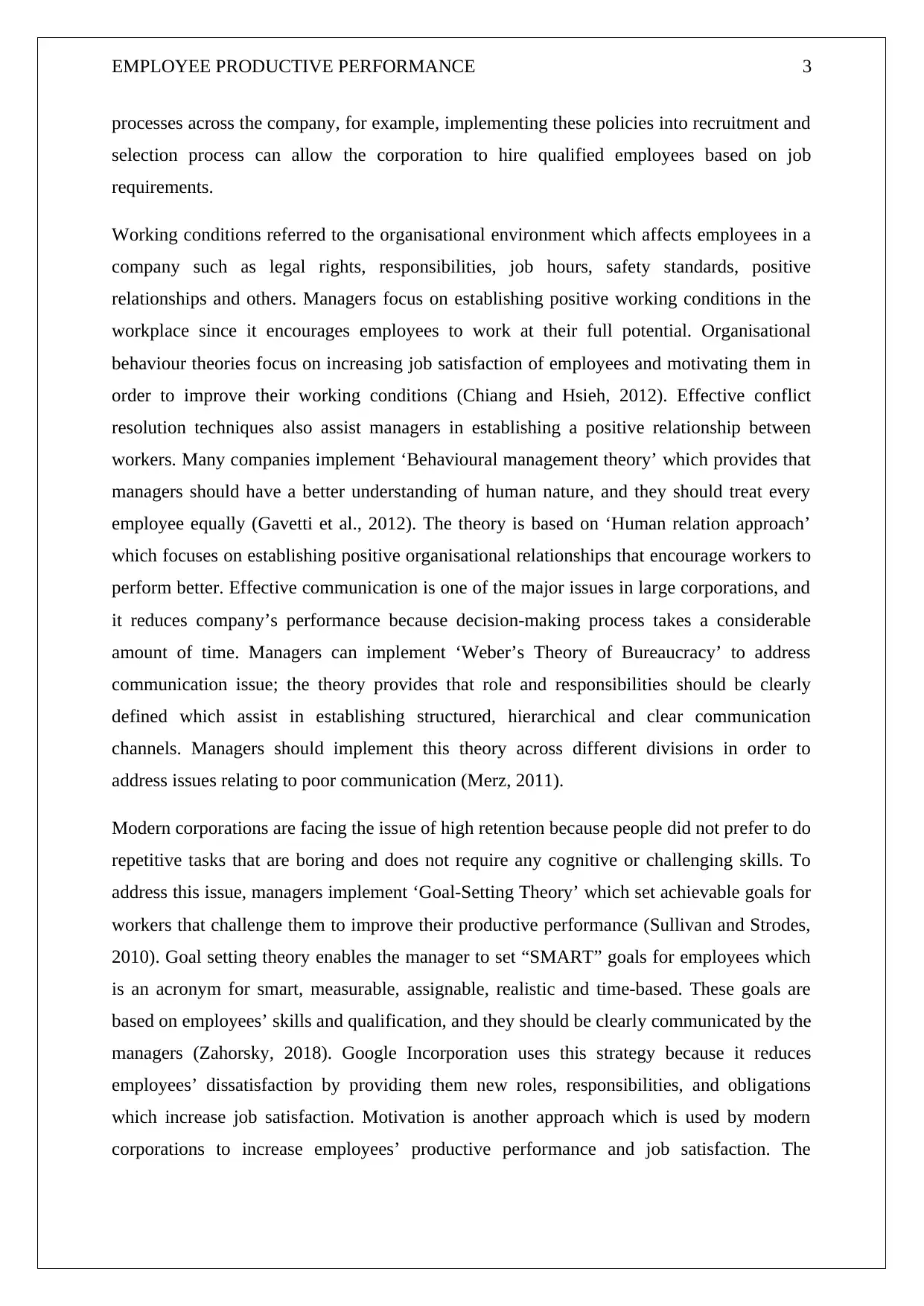
EMPLOYEE PRODUCTIVE PERFORMANCE 3
processes across the company, for example, implementing these policies into recruitment and
selection process can allow the corporation to hire qualified employees based on job
requirements.
Working conditions referred to the organisational environment which affects employees in a
company such as legal rights, responsibilities, job hours, safety standards, positive
relationships and others. Managers focus on establishing positive working conditions in the
workplace since it encourages employees to work at their full potential. Organisational
behaviour theories focus on increasing job satisfaction of employees and motivating them in
order to improve their working conditions (Chiang and Hsieh, 2012). Effective conflict
resolution techniques also assist managers in establishing a positive relationship between
workers. Many companies implement ‘Behavioural management theory’ which provides that
managers should have a better understanding of human nature, and they should treat every
employee equally (Gavetti et al., 2012). The theory is based on ‘Human relation approach’
which focuses on establishing positive organisational relationships that encourage workers to
perform better. Effective communication is one of the major issues in large corporations, and
it reduces company’s performance because decision-making process takes a considerable
amount of time. Managers can implement ‘Weber’s Theory of Bureaucracy’ to address
communication issue; the theory provides that role and responsibilities should be clearly
defined which assist in establishing structured, hierarchical and clear communication
channels. Managers should implement this theory across different divisions in order to
address issues relating to poor communication (Merz, 2011).
Modern corporations are facing the issue of high retention because people did not prefer to do
repetitive tasks that are boring and does not require any cognitive or challenging skills. To
address this issue, managers implement ‘Goal-Setting Theory’ which set achievable goals for
workers that challenge them to improve their productive performance (Sullivan and Strodes,
2010). Goal setting theory enables the manager to set “SMART” goals for employees which
is an acronym for smart, measurable, assignable, realistic and time-based. These goals are
based on employees’ skills and qualification, and they should be clearly communicated by the
managers (Zahorsky, 2018). Google Incorporation uses this strategy because it reduces
employees’ dissatisfaction by providing them new roles, responsibilities, and obligations
which increase job satisfaction. Motivation is another approach which is used by modern
corporations to increase employees’ productive performance and job satisfaction. The
processes across the company, for example, implementing these policies into recruitment and
selection process can allow the corporation to hire qualified employees based on job
requirements.
Working conditions referred to the organisational environment which affects employees in a
company such as legal rights, responsibilities, job hours, safety standards, positive
relationships and others. Managers focus on establishing positive working conditions in the
workplace since it encourages employees to work at their full potential. Organisational
behaviour theories focus on increasing job satisfaction of employees and motivating them in
order to improve their working conditions (Chiang and Hsieh, 2012). Effective conflict
resolution techniques also assist managers in establishing a positive relationship between
workers. Many companies implement ‘Behavioural management theory’ which provides that
managers should have a better understanding of human nature, and they should treat every
employee equally (Gavetti et al., 2012). The theory is based on ‘Human relation approach’
which focuses on establishing positive organisational relationships that encourage workers to
perform better. Effective communication is one of the major issues in large corporations, and
it reduces company’s performance because decision-making process takes a considerable
amount of time. Managers can implement ‘Weber’s Theory of Bureaucracy’ to address
communication issue; the theory provides that role and responsibilities should be clearly
defined which assist in establishing structured, hierarchical and clear communication
channels. Managers should implement this theory across different divisions in order to
address issues relating to poor communication (Merz, 2011).
Modern corporations are facing the issue of high retention because people did not prefer to do
repetitive tasks that are boring and does not require any cognitive or challenging skills. To
address this issue, managers implement ‘Goal-Setting Theory’ which set achievable goals for
workers that challenge them to improve their productive performance (Sullivan and Strodes,
2010). Goal setting theory enables the manager to set “SMART” goals for employees which
is an acronym for smart, measurable, assignable, realistic and time-based. These goals are
based on employees’ skills and qualification, and they should be clearly communicated by the
managers (Zahorsky, 2018). Google Incorporation uses this strategy because it reduces
employees’ dissatisfaction by providing them new roles, responsibilities, and obligations
which increase job satisfaction. Motivation is another approach which is used by modern
corporations to increase employees’ productive performance and job satisfaction. The
Paraphrase This Document
Need a fresh take? Get an instant paraphrase of this document with our AI Paraphraser
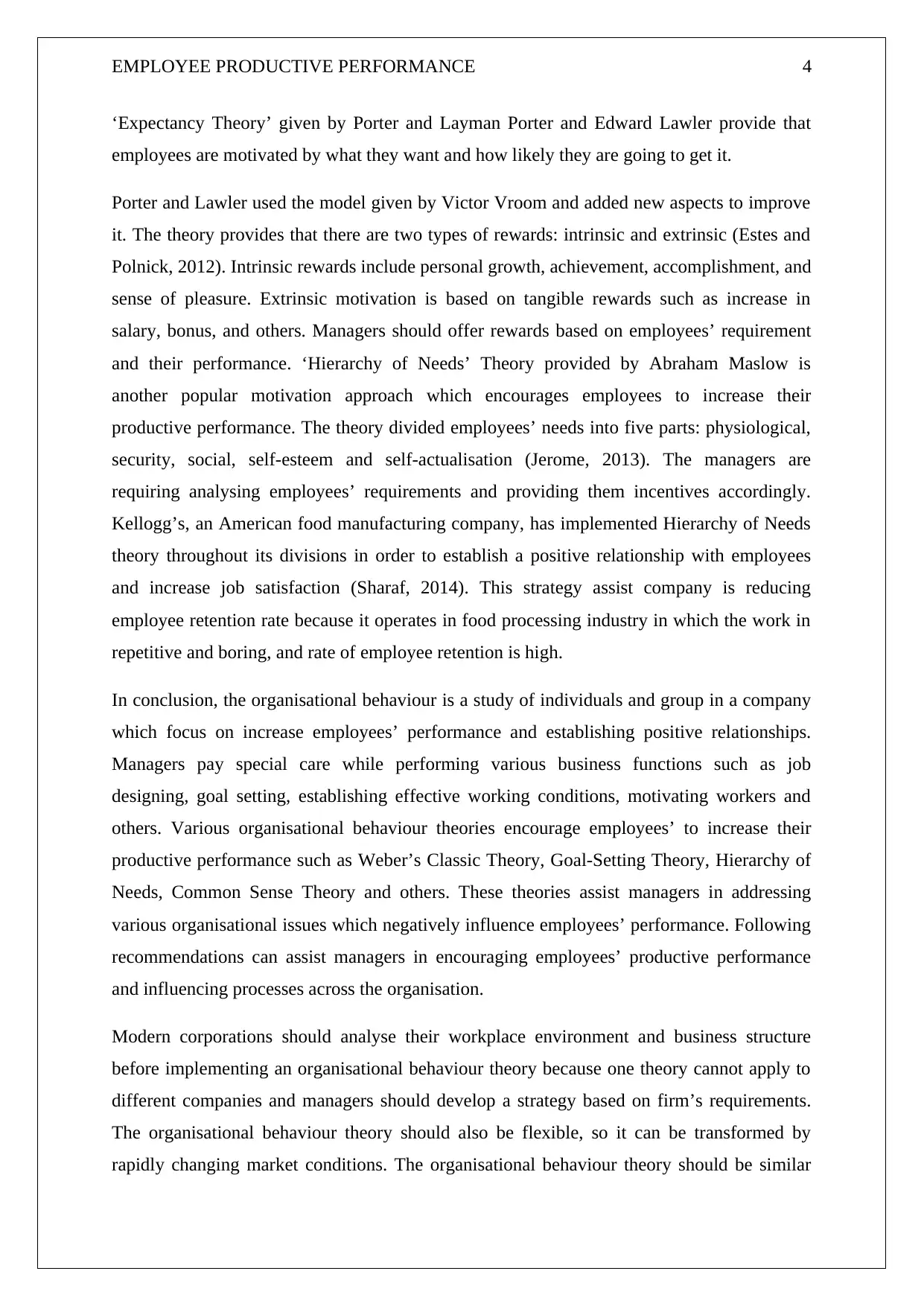
EMPLOYEE PRODUCTIVE PERFORMANCE 4
‘Expectancy Theory’ given by Porter and Layman Porter and Edward Lawler provide that
employees are motivated by what they want and how likely they are going to get it.
Porter and Lawler used the model given by Victor Vroom and added new aspects to improve
it. The theory provides that there are two types of rewards: intrinsic and extrinsic (Estes and
Polnick, 2012). Intrinsic rewards include personal growth, achievement, accomplishment, and
sense of pleasure. Extrinsic motivation is based on tangible rewards such as increase in
salary, bonus, and others. Managers should offer rewards based on employees’ requirement
and their performance. ‘Hierarchy of Needs’ Theory provided by Abraham Maslow is
another popular motivation approach which encourages employees to increase their
productive performance. The theory divided employees’ needs into five parts: physiological,
security, social, self-esteem and self-actualisation (Jerome, 2013). The managers are
requiring analysing employees’ requirements and providing them incentives accordingly.
Kellogg’s, an American food manufacturing company, has implemented Hierarchy of Needs
theory throughout its divisions in order to establish a positive relationship with employees
and increase job satisfaction (Sharaf, 2014). This strategy assist company is reducing
employee retention rate because it operates in food processing industry in which the work in
repetitive and boring, and rate of employee retention is high.
In conclusion, the organisational behaviour is a study of individuals and group in a company
which focus on increase employees’ performance and establishing positive relationships.
Managers pay special care while performing various business functions such as job
designing, goal setting, establishing effective working conditions, motivating workers and
others. Various organisational behaviour theories encourage employees’ to increase their
productive performance such as Weber’s Classic Theory, Goal-Setting Theory, Hierarchy of
Needs, Common Sense Theory and others. These theories assist managers in addressing
various organisational issues which negatively influence employees’ performance. Following
recommendations can assist managers in encouraging employees’ productive performance
and influencing processes across the organisation.
Modern corporations should analyse their workplace environment and business structure
before implementing an organisational behaviour theory because one theory cannot apply to
different companies and managers should develop a strategy based on firm’s requirements.
The organisational behaviour theory should also be flexible, so it can be transformed by
rapidly changing market conditions. The organisational behaviour theory should be similar
‘Expectancy Theory’ given by Porter and Layman Porter and Edward Lawler provide that
employees are motivated by what they want and how likely they are going to get it.
Porter and Lawler used the model given by Victor Vroom and added new aspects to improve
it. The theory provides that there are two types of rewards: intrinsic and extrinsic (Estes and
Polnick, 2012). Intrinsic rewards include personal growth, achievement, accomplishment, and
sense of pleasure. Extrinsic motivation is based on tangible rewards such as increase in
salary, bonus, and others. Managers should offer rewards based on employees’ requirement
and their performance. ‘Hierarchy of Needs’ Theory provided by Abraham Maslow is
another popular motivation approach which encourages employees to increase their
productive performance. The theory divided employees’ needs into five parts: physiological,
security, social, self-esteem and self-actualisation (Jerome, 2013). The managers are
requiring analysing employees’ requirements and providing them incentives accordingly.
Kellogg’s, an American food manufacturing company, has implemented Hierarchy of Needs
theory throughout its divisions in order to establish a positive relationship with employees
and increase job satisfaction (Sharaf, 2014). This strategy assist company is reducing
employee retention rate because it operates in food processing industry in which the work in
repetitive and boring, and rate of employee retention is high.
In conclusion, the organisational behaviour is a study of individuals and group in a company
which focus on increase employees’ performance and establishing positive relationships.
Managers pay special care while performing various business functions such as job
designing, goal setting, establishing effective working conditions, motivating workers and
others. Various organisational behaviour theories encourage employees’ to increase their
productive performance such as Weber’s Classic Theory, Goal-Setting Theory, Hierarchy of
Needs, Common Sense Theory and others. These theories assist managers in addressing
various organisational issues which negatively influence employees’ performance. Following
recommendations can assist managers in encouraging employees’ productive performance
and influencing processes across the organisation.
Modern corporations should analyse their workplace environment and business structure
before implementing an organisational behaviour theory because one theory cannot apply to
different companies and managers should develop a strategy based on firm’s requirements.
The organisational behaviour theory should also be flexible, so it can be transformed by
rapidly changing market conditions. The organisational behaviour theory should be similar
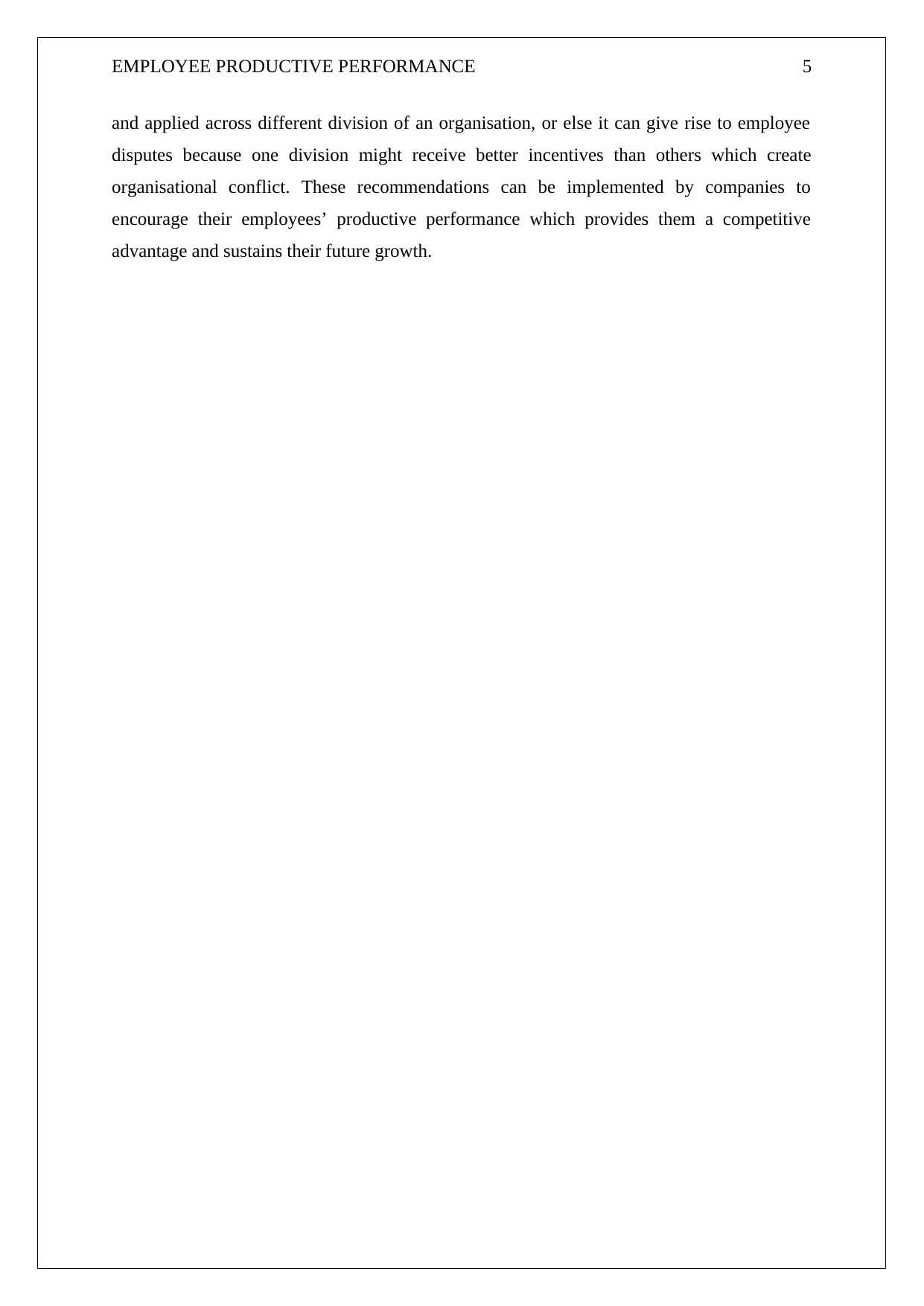
EMPLOYEE PRODUCTIVE PERFORMANCE 5
and applied across different division of an organisation, or else it can give rise to employee
disputes because one division might receive better incentives than others which create
organisational conflict. These recommendations can be implemented by companies to
encourage their employees’ productive performance which provides them a competitive
advantage and sustains their future growth.
and applied across different division of an organisation, or else it can give rise to employee
disputes because one division might receive better incentives than others which create
organisational conflict. These recommendations can be implemented by companies to
encourage their employees’ productive performance which provides them a competitive
advantage and sustains their future growth.
⊘ This is a preview!⊘
Do you want full access?
Subscribe today to unlock all pages.

Trusted by 1+ million students worldwide
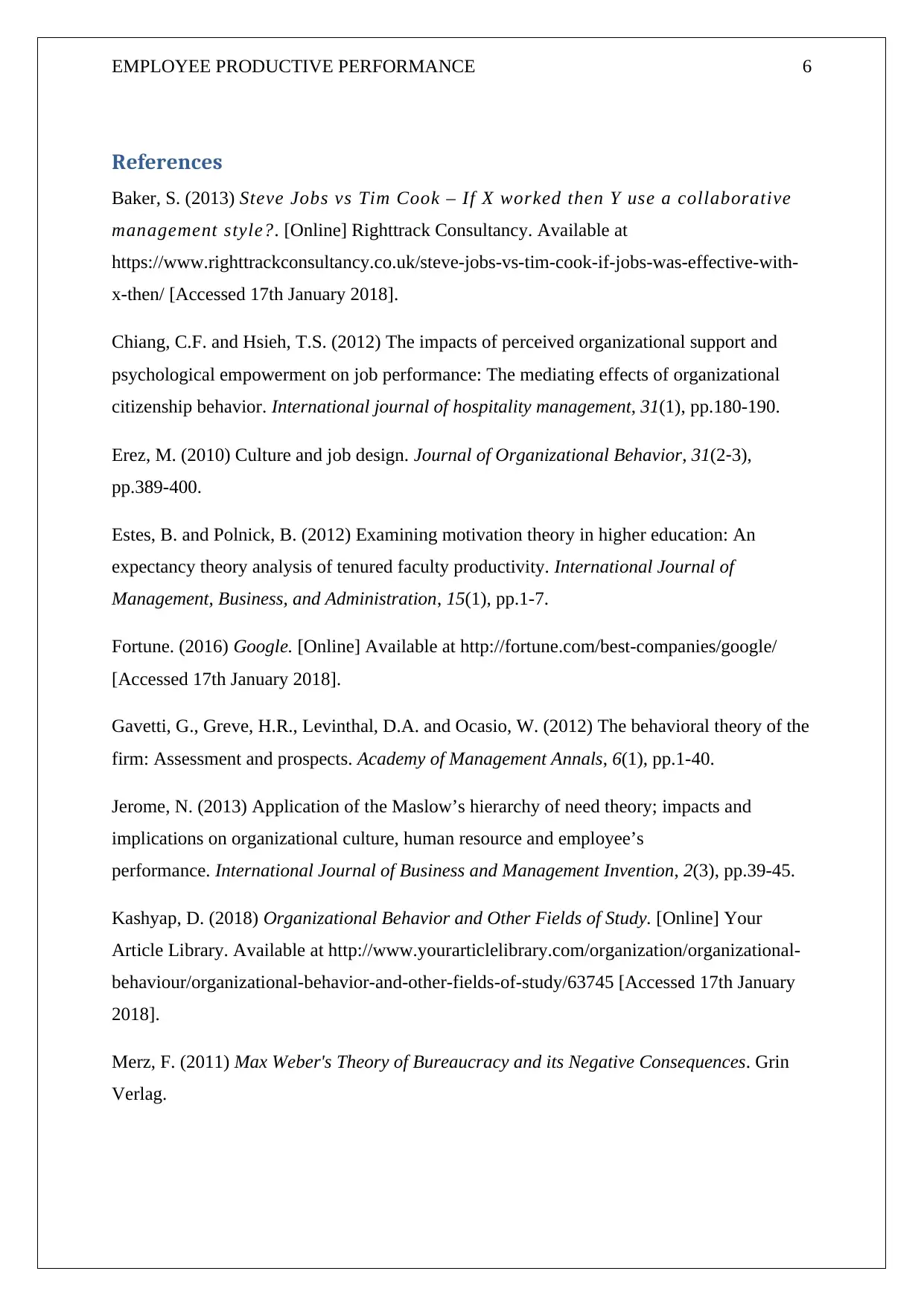
EMPLOYEE PRODUCTIVE PERFORMANCE 6
References
Baker, S. (2013) Steve Jobs vs Tim Cook – If X worked then Y use a collaborative
management style?. [Online] Righttrack Consultancy. Available at
https://www.righttrackconsultancy.co.uk/steve-jobs-vs-tim-cook-if-jobs-was-effective-with-
x-then/ [Accessed 17th January 2018].
Chiang, C.F. and Hsieh, T.S. (2012) The impacts of perceived organizational support and
psychological empowerment on job performance: The mediating effects of organizational
citizenship behavior. International journal of hospitality management, 31(1), pp.180-190.
Erez, M. (2010) Culture and job design. Journal of Organizational Behavior, 31(2‐3),
pp.389-400.
Estes, B. and Polnick, B. (2012) Examining motivation theory in higher education: An
expectancy theory analysis of tenured faculty productivity. International Journal of
Management, Business, and Administration, 15(1), pp.1-7.
Fortune. (2016) Google. [Online] Available at http://fortune.com/best-companies/google/
[Accessed 17th January 2018].
Gavetti, G., Greve, H.R., Levinthal, D.A. and Ocasio, W. (2012) The behavioral theory of the
firm: Assessment and prospects. Academy of Management Annals, 6(1), pp.1-40.
Jerome, N. (2013) Application of the Maslow’s hierarchy of need theory; impacts and
implications on organizational culture, human resource and employee’s
performance. International Journal of Business and Management Invention, 2(3), pp.39-45.
Kashyap, D. (2018) Organizational Behavior and Other Fields of Study. [Online] Your
Article Library. Available at http://www.yourarticlelibrary.com/organization/organizational-
behaviour/organizational-behavior-and-other-fields-of-study/63745 [Accessed 17th January
2018].
Merz, F. (2011) Max Weber's Theory of Bureaucracy and its Negative Consequences. Grin
Verlag.
References
Baker, S. (2013) Steve Jobs vs Tim Cook – If X worked then Y use a collaborative
management style?. [Online] Righttrack Consultancy. Available at
https://www.righttrackconsultancy.co.uk/steve-jobs-vs-tim-cook-if-jobs-was-effective-with-
x-then/ [Accessed 17th January 2018].
Chiang, C.F. and Hsieh, T.S. (2012) The impacts of perceived organizational support and
psychological empowerment on job performance: The mediating effects of organizational
citizenship behavior. International journal of hospitality management, 31(1), pp.180-190.
Erez, M. (2010) Culture and job design. Journal of Organizational Behavior, 31(2‐3),
pp.389-400.
Estes, B. and Polnick, B. (2012) Examining motivation theory in higher education: An
expectancy theory analysis of tenured faculty productivity. International Journal of
Management, Business, and Administration, 15(1), pp.1-7.
Fortune. (2016) Google. [Online] Available at http://fortune.com/best-companies/google/
[Accessed 17th January 2018].
Gavetti, G., Greve, H.R., Levinthal, D.A. and Ocasio, W. (2012) The behavioral theory of the
firm: Assessment and prospects. Academy of Management Annals, 6(1), pp.1-40.
Jerome, N. (2013) Application of the Maslow’s hierarchy of need theory; impacts and
implications on organizational culture, human resource and employee’s
performance. International Journal of Business and Management Invention, 2(3), pp.39-45.
Kashyap, D. (2018) Organizational Behavior and Other Fields of Study. [Online] Your
Article Library. Available at http://www.yourarticlelibrary.com/organization/organizational-
behaviour/organizational-behavior-and-other-fields-of-study/63745 [Accessed 17th January
2018].
Merz, F. (2011) Max Weber's Theory of Bureaucracy and its Negative Consequences. Grin
Verlag.
Paraphrase This Document
Need a fresh take? Get an instant paraphrase of this document with our AI Paraphraser
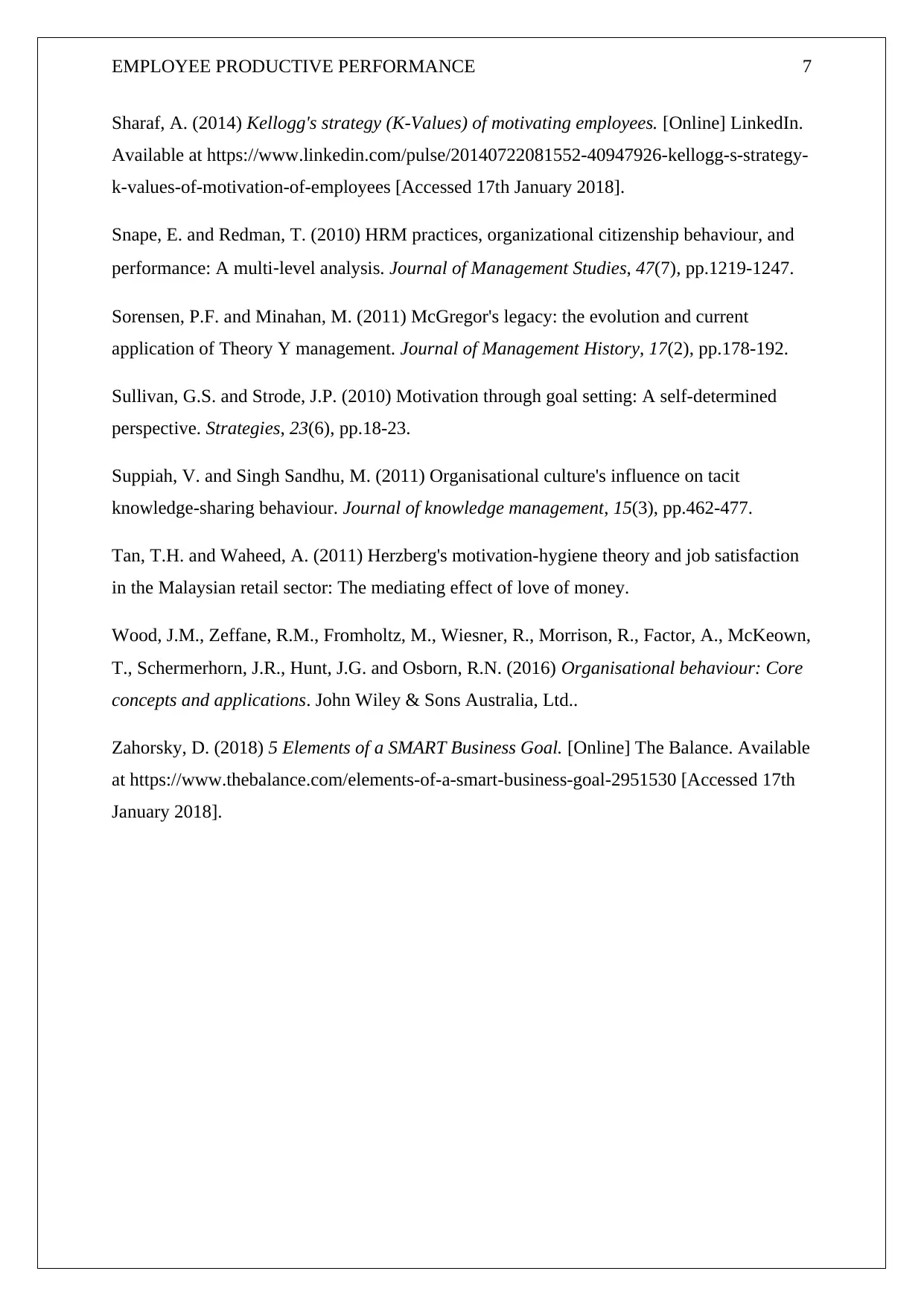
EMPLOYEE PRODUCTIVE PERFORMANCE 7
Sharaf, A. (2014) Kellogg's strategy (K-Values) of motivating employees. [Online] LinkedIn.
Available at https://www.linkedin.com/pulse/20140722081552-40947926-kellogg-s-strategy-
k-values-of-motivation-of-employees [Accessed 17th January 2018].
Snape, E. and Redman, T. (2010) HRM practices, organizational citizenship behaviour, and
performance: A multi‐level analysis. Journal of Management Studies, 47(7), pp.1219-1247.
Sorensen, P.F. and Minahan, M. (2011) McGregor's legacy: the evolution and current
application of Theory Y management. Journal of Management History, 17(2), pp.178-192.
Sullivan, G.S. and Strode, J.P. (2010) Motivation through goal setting: A self-determined
perspective. Strategies, 23(6), pp.18-23.
Suppiah, V. and Singh Sandhu, M. (2011) Organisational culture's influence on tacit
knowledge-sharing behaviour. Journal of knowledge management, 15(3), pp.462-477.
Tan, T.H. and Waheed, A. (2011) Herzberg's motivation-hygiene theory and job satisfaction
in the Malaysian retail sector: The mediating effect of love of money.
Wood, J.M., Zeffane, R.M., Fromholtz, M., Wiesner, R., Morrison, R., Factor, A., McKeown,
T., Schermerhorn, J.R., Hunt, J.G. and Osborn, R.N. (2016) Organisational behaviour: Core
concepts and applications. John Wiley & Sons Australia, Ltd..
Zahorsky, D. (2018) 5 Elements of a SMART Business Goal. [Online] The Balance. Available
at https://www.thebalance.com/elements-of-a-smart-business-goal-2951530 [Accessed 17th
January 2018].
Sharaf, A. (2014) Kellogg's strategy (K-Values) of motivating employees. [Online] LinkedIn.
Available at https://www.linkedin.com/pulse/20140722081552-40947926-kellogg-s-strategy-
k-values-of-motivation-of-employees [Accessed 17th January 2018].
Snape, E. and Redman, T. (2010) HRM practices, organizational citizenship behaviour, and
performance: A multi‐level analysis. Journal of Management Studies, 47(7), pp.1219-1247.
Sorensen, P.F. and Minahan, M. (2011) McGregor's legacy: the evolution and current
application of Theory Y management. Journal of Management History, 17(2), pp.178-192.
Sullivan, G.S. and Strode, J.P. (2010) Motivation through goal setting: A self-determined
perspective. Strategies, 23(6), pp.18-23.
Suppiah, V. and Singh Sandhu, M. (2011) Organisational culture's influence on tacit
knowledge-sharing behaviour. Journal of knowledge management, 15(3), pp.462-477.
Tan, T.H. and Waheed, A. (2011) Herzberg's motivation-hygiene theory and job satisfaction
in the Malaysian retail sector: The mediating effect of love of money.
Wood, J.M., Zeffane, R.M., Fromholtz, M., Wiesner, R., Morrison, R., Factor, A., McKeown,
T., Schermerhorn, J.R., Hunt, J.G. and Osborn, R.N. (2016) Organisational behaviour: Core
concepts and applications. John Wiley & Sons Australia, Ltd..
Zahorsky, D. (2018) 5 Elements of a SMART Business Goal. [Online] The Balance. Available
at https://www.thebalance.com/elements-of-a-smart-business-goal-2951530 [Accessed 17th
January 2018].
1 out of 8
Related Documents
Your All-in-One AI-Powered Toolkit for Academic Success.
+13062052269
info@desklib.com
Available 24*7 on WhatsApp / Email
![[object Object]](/_next/static/media/star-bottom.7253800d.svg)
Unlock your academic potential
Copyright © 2020–2025 A2Z Services. All Rights Reserved. Developed and managed by ZUCOL.




